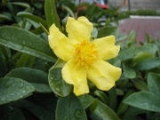
Hibbertia scandens
Encyclopedia
Hibbertia scandens is a vine
which is native to Australia
.
who gave it the name Dillenia scandens. The specific epithet scandens is derived from Latin, and means "to climb". In 1805, Swedish botanist Jonas Dryander
transferred the species into the genus Hibbertia.
Vine
A vine in the narrowest sense is the grapevine , but more generally it can refer to any plant with a growth habit of trailing or scandent, that is to say climbing, stems or runners...
which is native to Australia
Australia
Australia , officially the Commonwealth of Australia, is a country in the Southern Hemisphere comprising the mainland of the Australian continent, the island of Tasmania, and numerous smaller islands in the Indian and Pacific Oceans. It is the world's sixth-largest country by total area...
.
Description
The yellow flowers have been reported as having an unpleasant odour variously described as similar to mothballs or animal urine or sweet but with "a pronounced faecel element". The leaves are elliptic or obovate and average 6 cm in length.Taxonomy
The species was first formally described in 1799 by German botanist Carl WilldenowCarl Ludwig Willdenow
Carl Ludwig Willdenow was a German botanist, pharmacist, and plant taxonomist. He is considered one of the founders of phytogeography, the study of the geographic distribution of plants...
who gave it the name Dillenia scandens. The specific epithet scandens is derived from Latin, and means "to climb". In 1805, Swedish botanist Jonas Dryander
Jonas Carlsson Dryander
Jonas Carlsson Dryander was a Swedish botanist.Dryander was born in Gothenburg. He was a pupil of Carolus Linnaeus at Uppsala University. He arrived in London on 10 July 1777...
transferred the species into the genus Hibbertia.

